How to control your food portion sizes
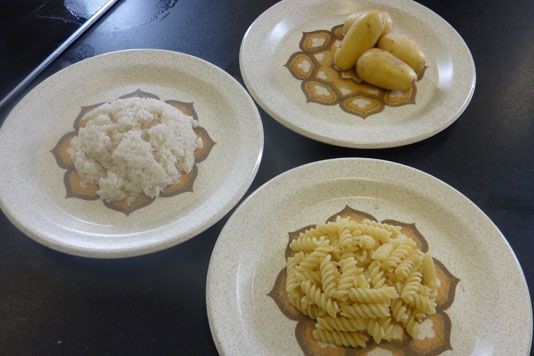
Trying to slim down after the excesses of Christmas? One of the best ways is to control your portions.
Prepare a bowl of cereal, and you’ll probably pour your Frosties until they reach the rim. The blanket of rice underneath chilli con carne usually covers the plate, and everyone has trouble finishing their bowl of spaghetti off. We’re never going to stop eating carbs – but should we be serving smaller portions of them when we do?
The lovefood test
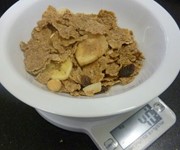 Team lovefood took to the kitchen to find out exactly what a recommended serving of carbs (pasta, new potatoes, rice and cereal) was according to Bupa, who base their advice on “…published guidelines that estimate an average person’s nutritional and energy requirements”.
Team lovefood took to the kitchen to find out exactly what a recommended serving of carbs (pasta, new potatoes, rice and cereal) was according to Bupa, who base their advice on “…published guidelines that estimate an average person’s nutritional and energy requirements”.
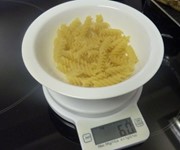 The results were staggering. 40g of cereal barely covered the bottom of a puny bowl (about 30-odd Fruit ‘n Fibre flakes). One serving of rice (75g, dry weight) seemed more at home on a child’s plate, and 60g of pasta (one serving) equated to 56 Fusilli pasta pieces exactly.
The results were staggering. 40g of cereal barely covered the bottom of a puny bowl (about 30-odd Fruit ‘n Fibre flakes). One serving of rice (75g, dry weight) seemed more at home on a child’s plate, and 60g of pasta (one serving) equated to 56 Fusilli pasta pieces exactly.
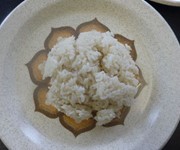 But to be fair, once we had cooked the experiment, the portions didn’t seem so mean. Because it had soaked up its cooking water, the pasta’s weight leapt from 60g to 110g and the rice even more so, from 75g to 173g. The potatoes remained the same, as did the mouse-size portion of cereal.
But to be fair, once we had cooked the experiment, the portions didn’t seem so mean. Because it had soaked up its cooking water, the pasta’s weight leapt from 60g to 110g and the rice even more so, from 75g to 173g. The potatoes remained the same, as did the mouse-size portion of cereal.
Your starchy guideline
According to Bupa, if you’re trying to maintain your weight it’s best to aim for between two and four portions of starchy food with every meal. That equates to 40g of cereal (three portions); 60g of dry pasta (three portions); 75g of dry rice (three portions); four small potatoes, each the size of an egg (two portions); two slices of bread (two portions); one medium baked potato (two portions); one block of dried noodles (one portion); or one filled pitta bread (two portions).
And if you’re trying to lose weight, you should only eat between five and eight portions of starchy foods a day. So for example, that could be one slice of toast for breakfast (one portion); a baked potato for lunch (two portions); and 75g of rice for dinner (three portions).
Joanna Greening from the British Dietetic Association has this advice: “It’s amazing how everyone has such varied ideas of portion sizes and what a difference this makes to total calories consumed. Try weighing out your food and comparing this to the food label portion sizes – you may be in for a shock. When having a treat, think about how much you need in order to enjoy it. Do you need a whole serving of dessert or are a few spoonfuls enough?”
Other food groups
Our main interest was carbohydrates, because that’s what people tend to go overboard on – partly, perhaps, because they’re the cheapest food group. But for reference, here’s what else you’re supposed to be eating...
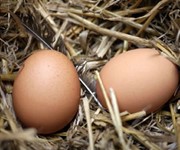 Protein: important for growth and repair.
Protein: important for growth and repair.
Three portions a day, with at least one portion of oily fish a week. One portion is equal to 100g raw/75g cooked lean meat; 75g oily fish or 150g white fish; two medium-sized eggs; half a tin of Baked Beans; four tablespoons of pulses, such as lentils or chickpeas; or two tablespoons of nuts.
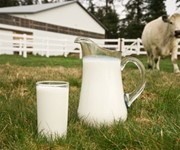 Dairy: contains calcium for healthy bones and teeth, and is also a good source of protein.
Dairy: contains calcium for healthy bones and teeth, and is also a good source of protein.
Three portions a day. One portion is equal to 200ml milk; a small pot of yoghurt; 30g hard cheese; or 90g cottage cheese.
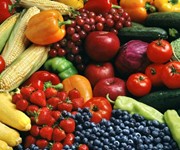 Fruit and veg: packed full of vitamins and minerals to keep you alive ‘n kicking.
Fruit and veg: packed full of vitamins and minerals to keep you alive ‘n kicking.
Five portions a day. One portion is equal to one or two slices of large fruit, such as mango or pineapple; one medium-size fruit, such as an apple, orange, banana or peach; two small fruits, such as kiwis, plums, satsumas or clementines; one to two handfuls of grapes or berries; 150ml (a small glass) juice; three heaped tablespoons peas, carrots, sweetcorn and mixed veg; one dessert bowl salad leaves; three heaped tablespoons beans.
Top tips for controlling your portions
It’s oh-so-easy to eat a larger serving than you’re supposed to – especially with cereal! Here are some top tips for staying on track:
1. Use smaller bowls and plates. You can’t eat half a box of Frosties if your bowl can’t take it. And if you use smaller plates, your serving of rice won’t look so disheartening.
2. A great one from Bupa: “You don’t need to cut down on your fruit and veg if you’re trying to lose weight. So if your plate is looking a bit sparse, fill it up with vegetables. And if you’re craving a mid-morning snack, go for a piece of fruit.”
3. If you’re really dedicated, start a food dairy and write down everything you eat in a day. It’s easy to forget the biscuits you scoffed for elevenses.
4. Always check the back of pasta, rice and other grain packets for the recommended portion size before cooking. Measure it out exactly, instead of just bunging in whatever you imagine will work. We tend to eat more than we should, to save chucking food away.
5. Remember, kids aren’t supposed to eat the same amount as you (apart from fruit and veg, which they should still have five portions of). Give them a different size plate and know that it’s ok if they don’t eat everything up.
Do you keep an eye on your serving sizes? And have you any top tips to share? Talk to us in the comments box below...
This is a classic lovefood article
You might also like
Comments
Be the first to comment
Do you want to comment on this article? You need to be signed in for this feature